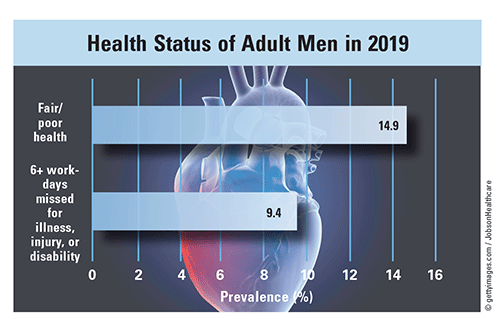US Pharm. 2021;46(6):14.
In 2019, according to the CDC, 58.5% more men were reported to be in fair or poor health compared with men who missed six or more workdays for illness, injury, or disability. More than 57% of men met the 2008 federal physical-activity guidelines for aerobic activity. However, 40.5% of men were obese, putting them at higher risk for developing cardiac problems, and 15.3% were cigarette smokers.

Prevalence of Selected Diseases: In men, hypertension and hypercholesterolemia were significantly more prevalent (27.2% and 20.7%, respectively) than coronary heart disease (5.9%), myocardial infarction (4.1%), and angina (1.7%). Nearly 52% of those who had hypertension were taking antihypertensives. Only 41.8% of men reached the Healthy People 2020 blood-pressure control target of 61.2% in 2017, and heart disease was responsible for 207.5 deaths per 100,000. Chronic respiratory diseases affected 43.7 per 100,000 men, with rates of 6.1% for asthma, 2.3% for asthma episode or attack, and 4.1% for chronic obstructive pulmonary disease, emphysema, or chronic bronchitis. Of all men, 8.4% felt anxious on a regular basis, and 7.1% were counseled and prescribed medication by a mental-health professional; 3.8% of men experienced depression, with 6.1% taking prescription drugs for it. Additionally, in 2017, 22.4 per 100,000 men committed suicide (rate 3.7 times higher than in women). The prevalence of diabetes was 9.5%; that for chronic pain was 19.1%; and that for arthritis was 18.3%.
Functioning Difficulties: In 2019, 18% fewer men than women had problems in one or more of the six functioning domains of disability: sight, hearing, mobility, communication, cognition, and self-care. Of these, 16.7% of men had difficulty hearing with or without hearing aids, 14.6% had difficulty seeing with or without eyeglasses or contact lenses, 15.5% had trouble walking or climbing steps, and 3.9% had problems with self-care (e.g., washing or dressing). Also, 5.2% of men had difficulty communicating, understanding, or being understood; 14.9% had trouble remembering or concentrating.
Healthcare Use: In 2019, 79.8% of men visited a physician, 73.6% had a wellness visit, 61.5% had a dental examination or cleaning, 42.8% received an influenza vaccination, and 83.9% had blood pressure checked by a healthcare professional. More than 59% of men took prescription medication, 19.7% had an emergency-department visit, and 25.7% had an urgent-care-center visit. Cost-related problems with care access were a factor for some men: 7.8% delayed getting medical care due to cost, and 2.6% did not get needed mental-health care; in order to save money, 7.9% did not take medication as prescribed.
The content contained in this article is for informational purposes only. The content is not intended to be a substitute for professional advice. Reliance on any information provided in this article is solely at your own risk.
To comment on this article, contact rdavidson@uspharmacist.com.





